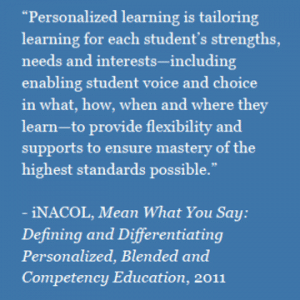Competency-Based Education and Personalized Learning Go Hand in Hand
Education Domain Blog
This is the fifth post in the blog series on the report, Quality and Equity by Design: Charting the Course for the Next Phase of Competency-Based Education.
 Competency-based structures focus upon each student’s unique K-12 educational journey while ensuring that all students emerge from their K-12 experience ready to pursue and succeed in the postsecondary pathway of their choice. In this way, they are designed for equity with a focus upon responsiveness, consistency, transparency, fairness and continuous improvement. As the learning sciences tell us, it is important to personalize learning rather than depend on the one-size-fits-all instruction and curriculum of the traditional system. In fact it would be nearly impossible to have all students reach college and career readiness without doing so.
Competency-based structures focus upon each student’s unique K-12 educational journey while ensuring that all students emerge from their K-12 experience ready to pursue and succeed in the postsecondary pathway of their choice. In this way, they are designed for equity with a focus upon responsiveness, consistency, transparency, fairness and continuous improvement. As the learning sciences tell us, it is important to personalize learning rather than depend on the one-size-fits-all instruction and curriculum of the traditional system. In fact it would be nearly impossible to have all students reach college and career readiness without doing so.
Competency-based education structures allow schools to meet students where they are; personalized learning is an approach to optimizing a school’s pedagogical strategy to effectively support each student, drawing on research about learning, motivation and engagement. In schools using personalized learning, students are active learners with:
- Choice in how they learn,
- Voice to co-create learning experiences and express their own ideas,
- Options to personalize their pathways, and
- Leadership opportunities in which they can shape or contribute to their own environment.
In order to become active learners who have a sense of ownership of their education, students need to have the right mix of mindsets and skills. Schools invest in helping students build the growth mindset and academic mindset as well as the habits of success and social-emotional skills they need to be self-directed learners and engage in productive struggle. Schools play a critical role in creating the learning opportunities and coaching that students need to successfully learn how to learn. Instruction is designed to meet students where they are, taking into account their prerequisite skills, mindsets, habits and interests.
Personalized learning relies on the competency-based structures that produce consistency in validating proficiency based on student work, and careful monitoring of pace and progress. This consistency and monitoring is important for districts and schools becoming accountable for student success. Personalization without a competency-based system has the potential to perpetuate and in some instances even exacerbate inequity. Competency education without personalization means that students will not receive the instruction and support they need to learn. While the design of competency-based structures and personalized learning practices naturally support equitable education, realizing this goal requires intentionality, as is discussed more within the report here.
Follow this blog series for more articles charting the course for the next phase of competency-based education, or download the full report:
- CompetencyWorks Releases New Report on Quality and Equity by Design: Charting the Course for the Next Phase of Competency-Based Education
- Readiness for College, Career and Life: The Purpose of K-12 Public Education Today
- Why A Competency-Based System Is Needed: 10 Ways the Traditional System Contributes to Inequity
- How Competency-Based Education Differs from the Traditional System of Education
More resources:
- Report: Quality and Equity by Design: Charting the Course for the Next Phase of Competency-Based Education
- Report: Understanding the Brain: The Birth of a Learning Science (OECD)
- Report: Motivation, Engagement and Student Voice (Students at the Center Hub)
- Report: What’s Possible with Personalized Learning? An Overview of Personalized Learning for Schools, Families and Communities (iNACOL)
- Report: Mean What You Say: Defining and Integrating Personalized, Blended and Competency Education (iNACOL)
- Report: Meeting Students Where They Are (CompetencyWorks and reDesign)
- Article: 15 Dimensions of Personalized Learning (Tom Vander Ark, CompetencyWorks)